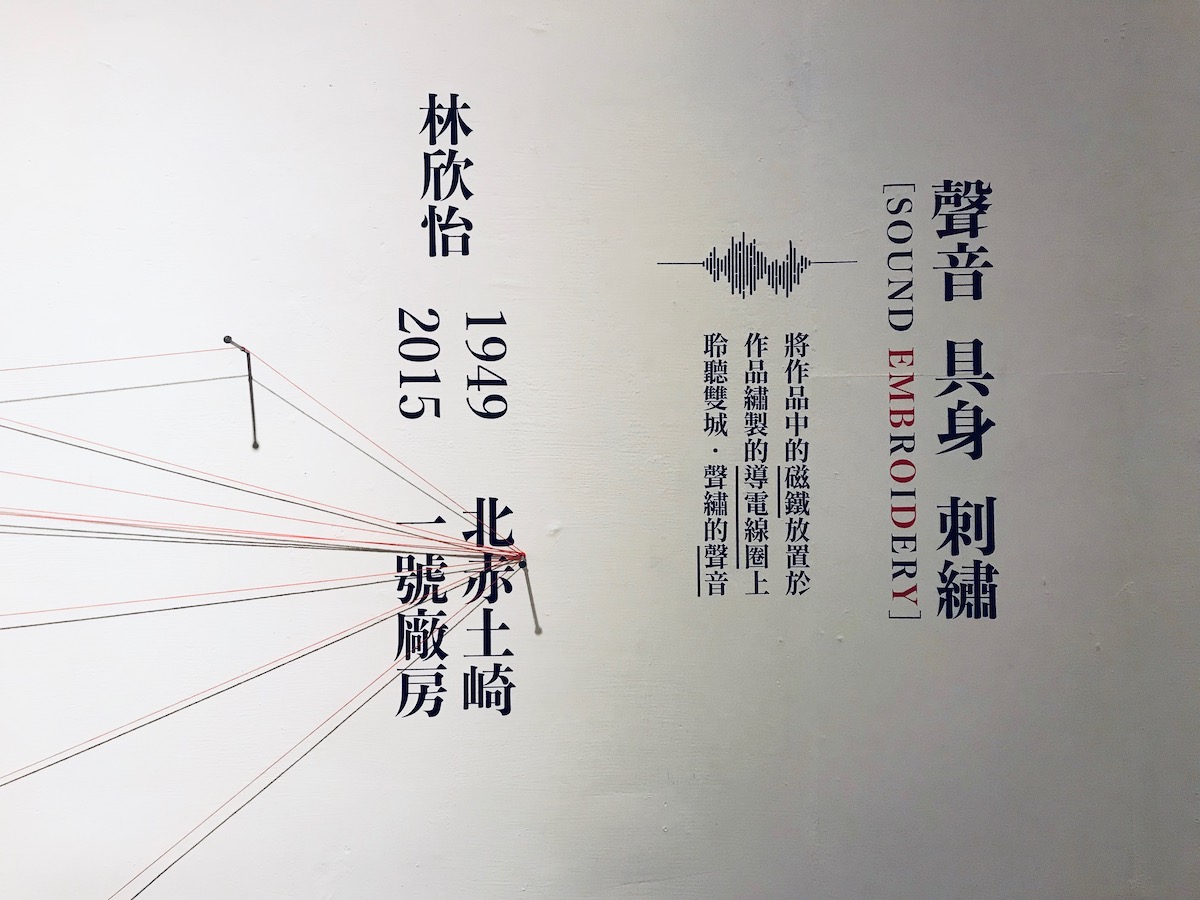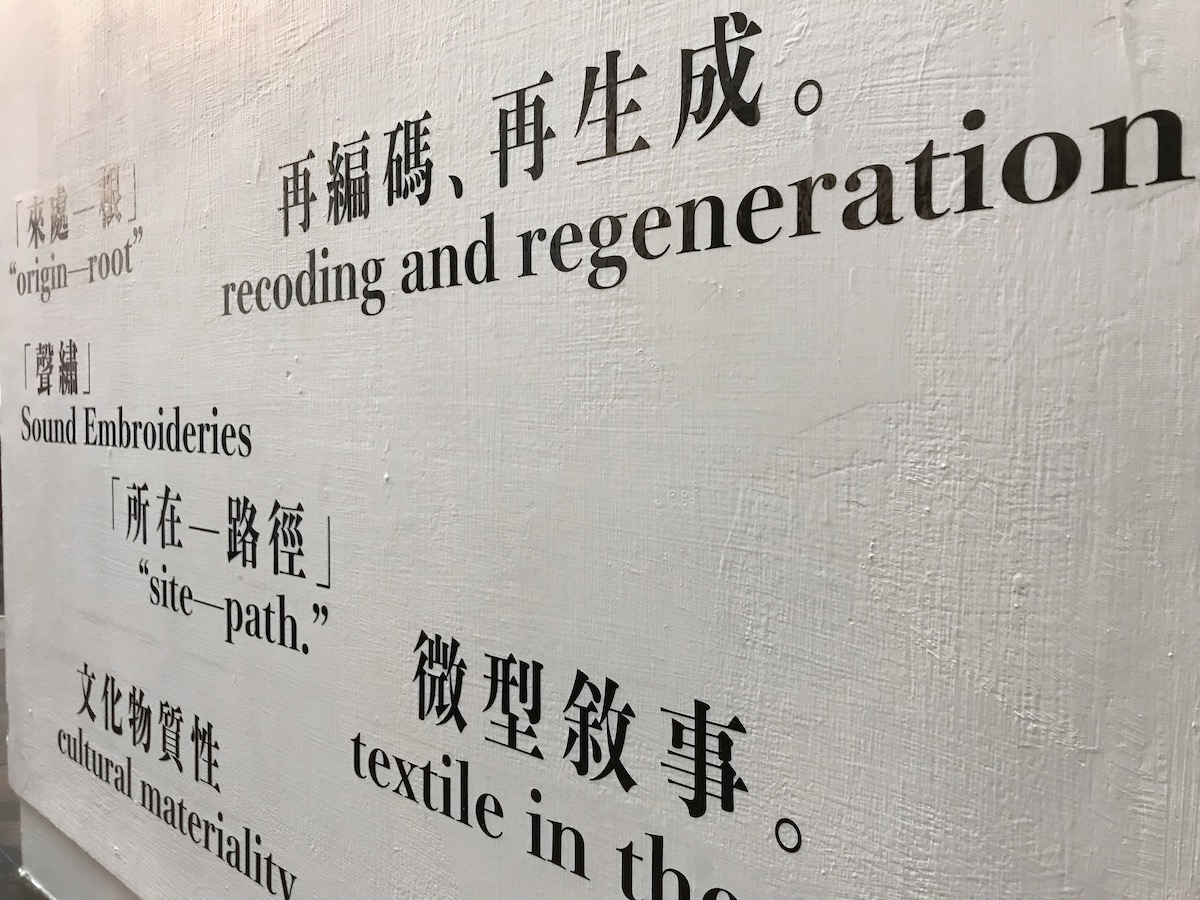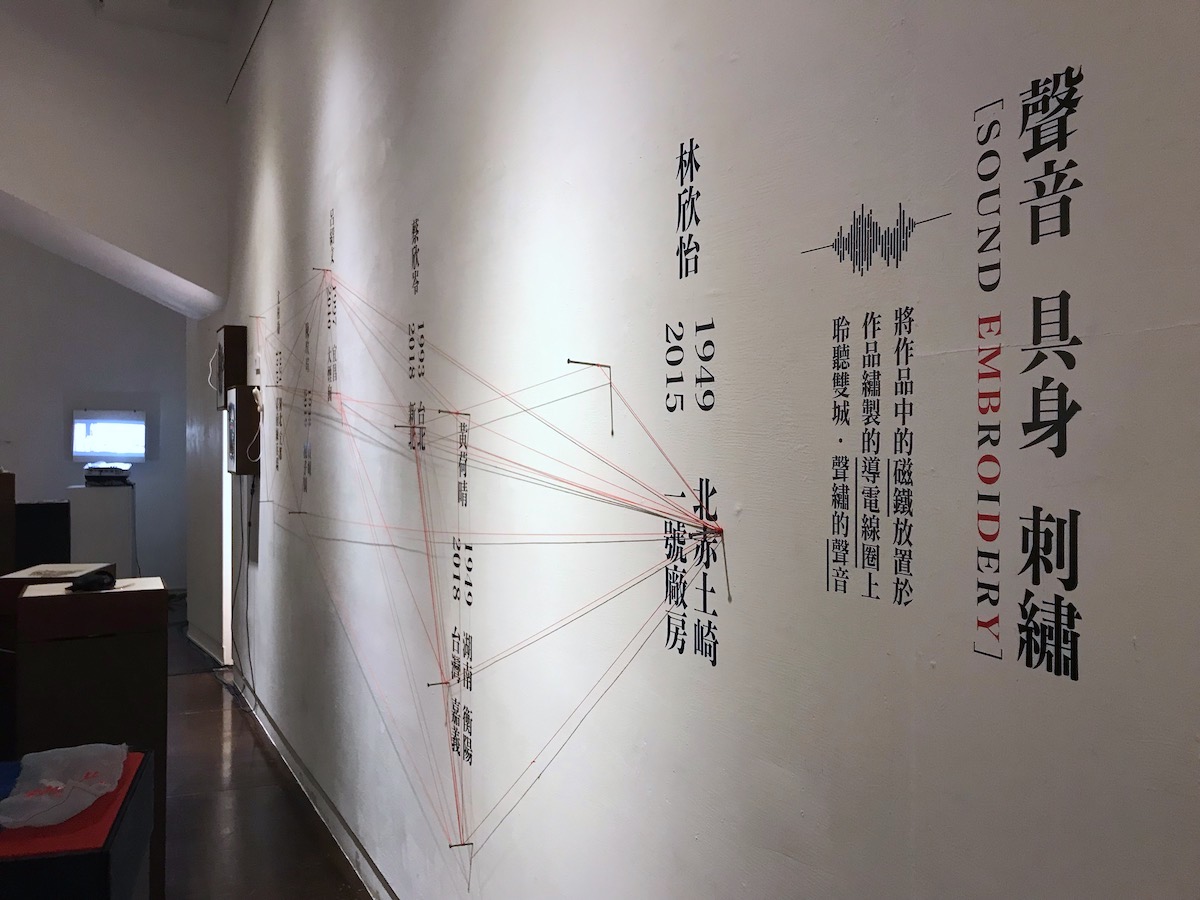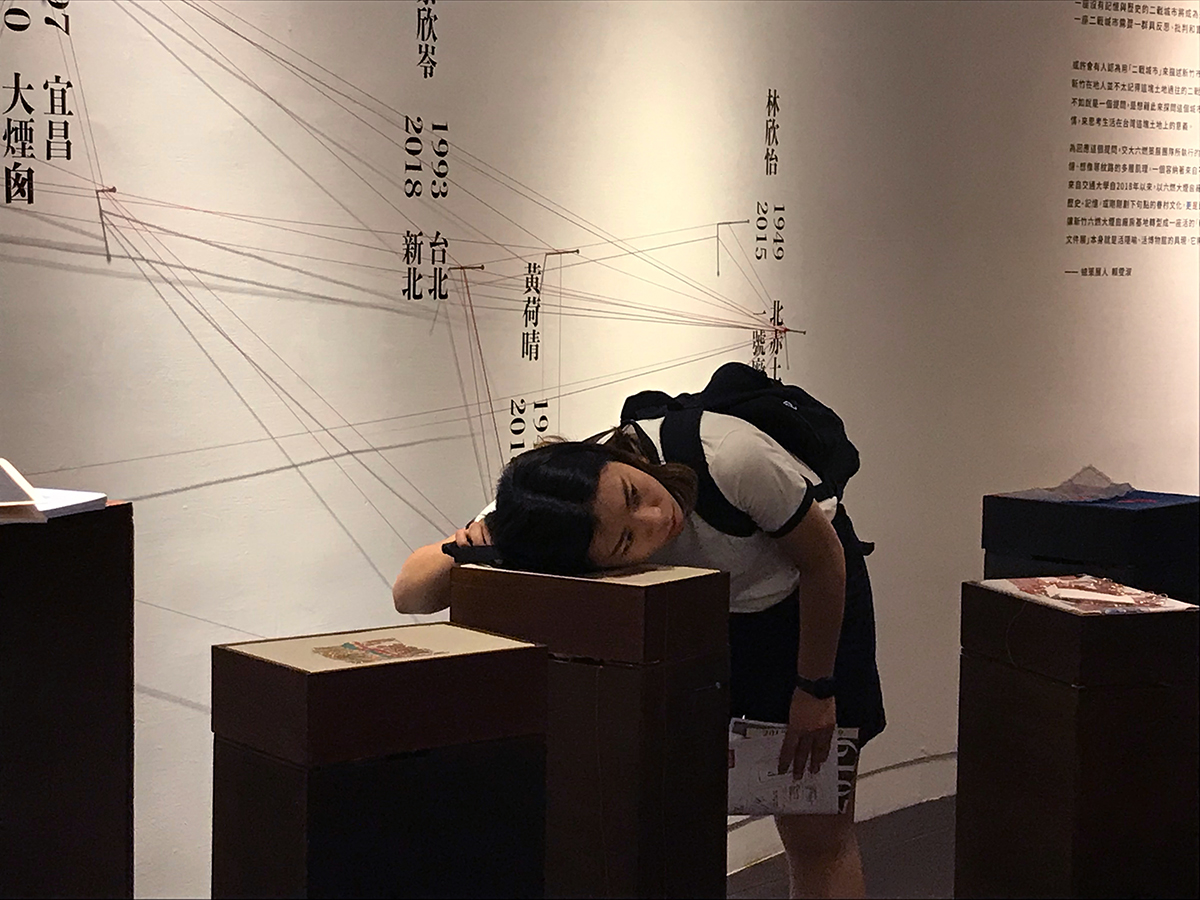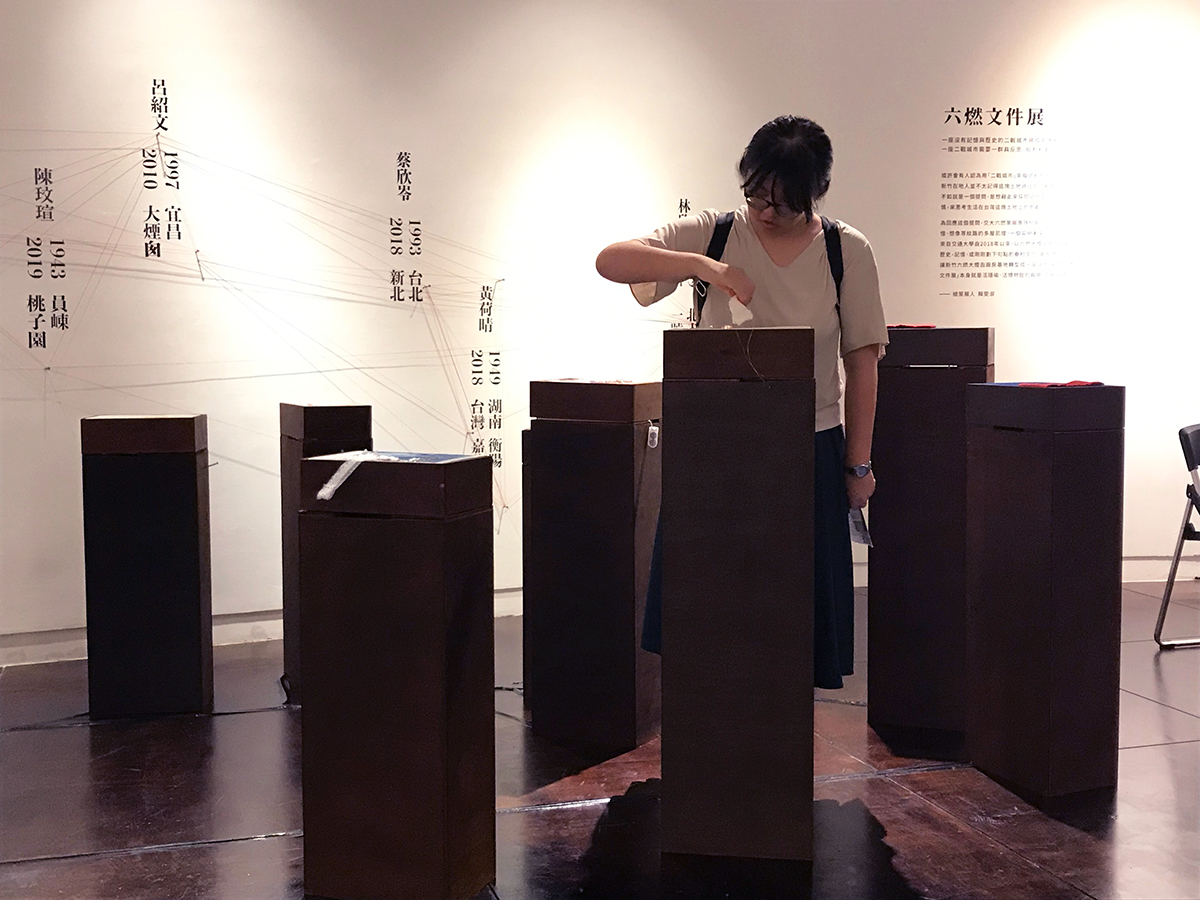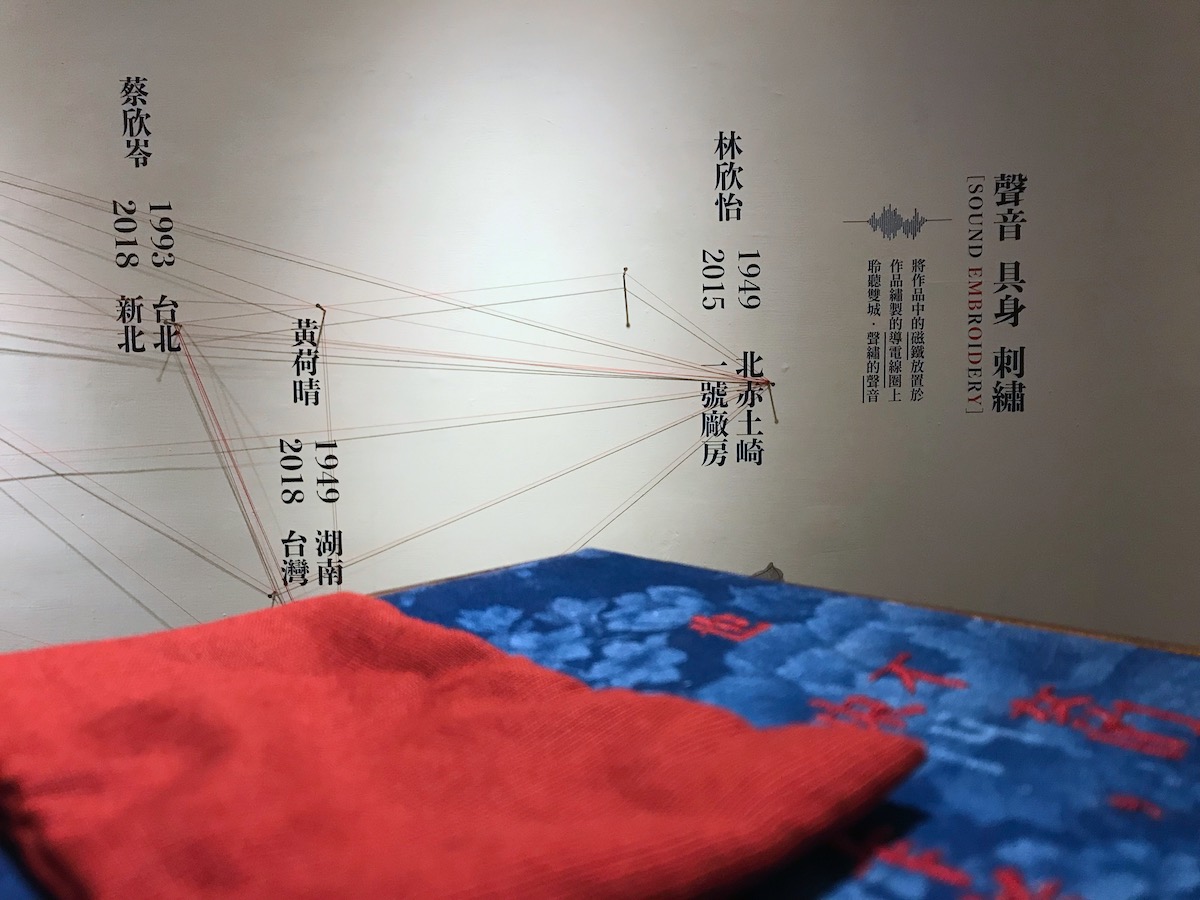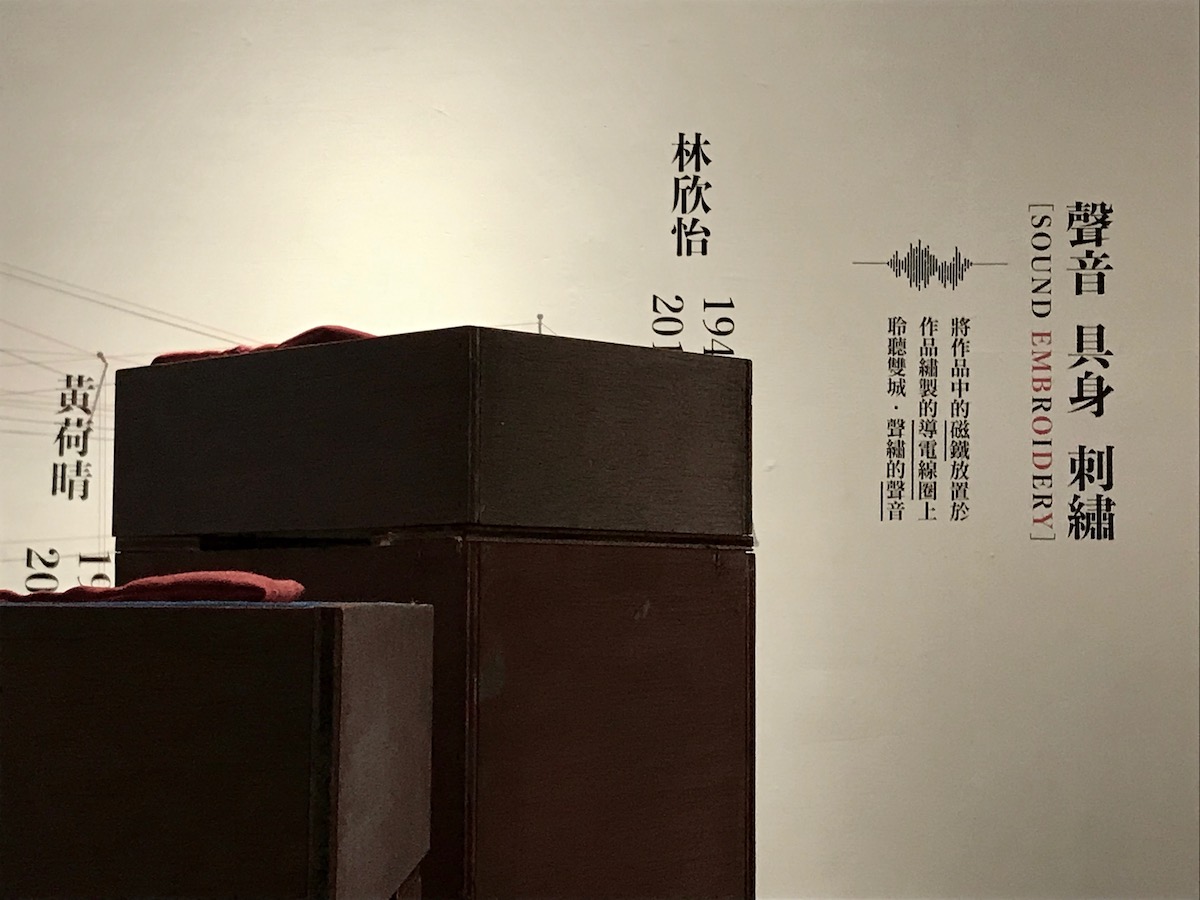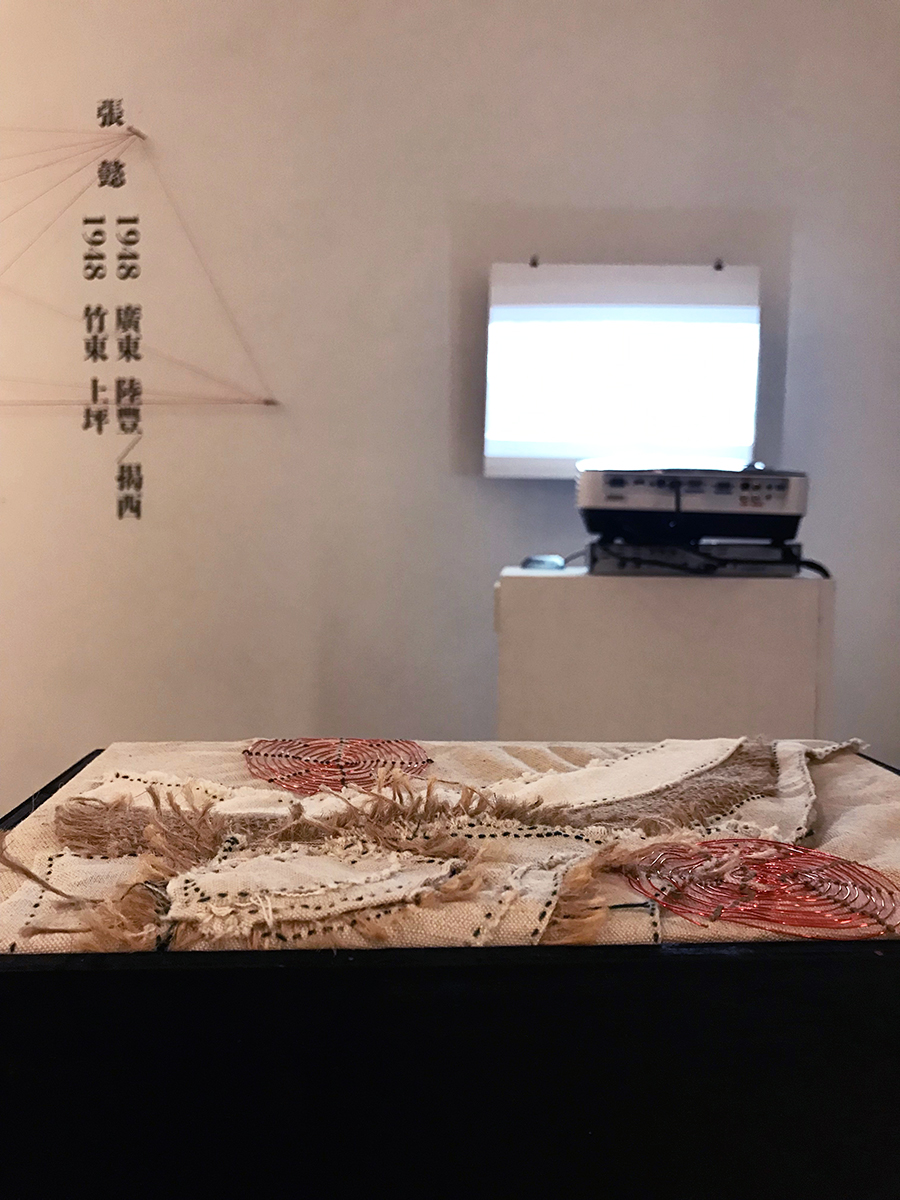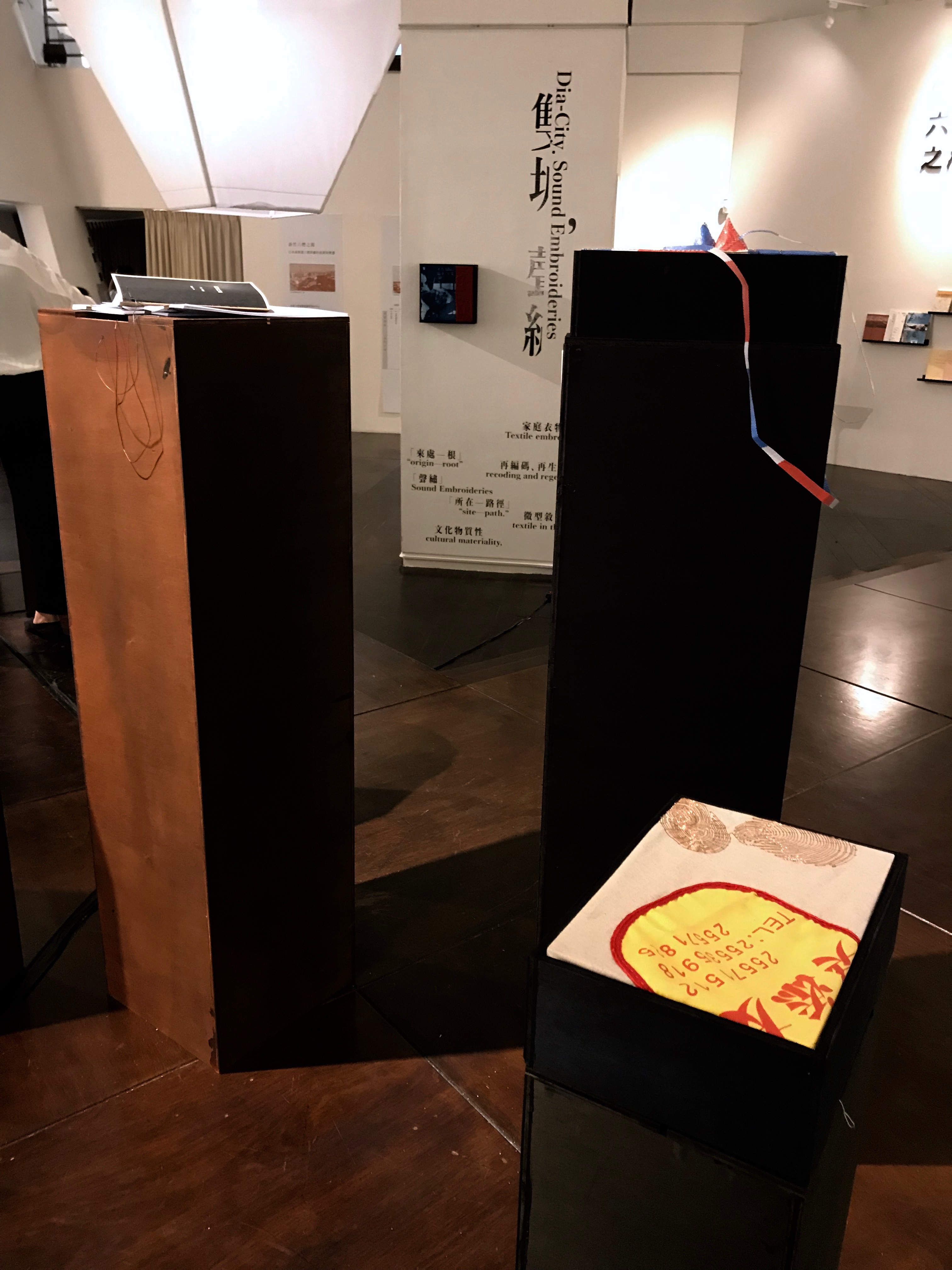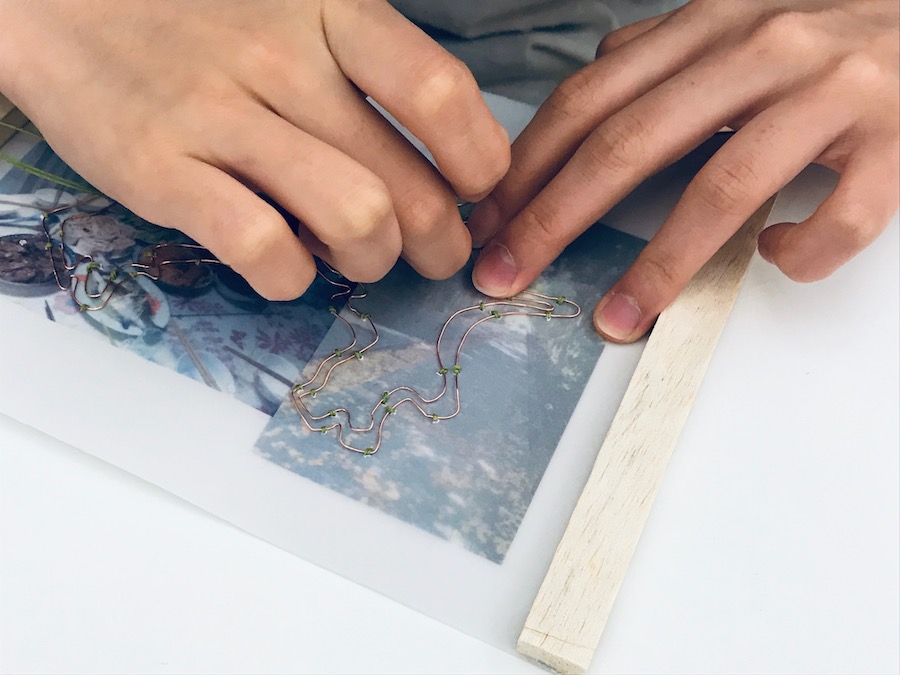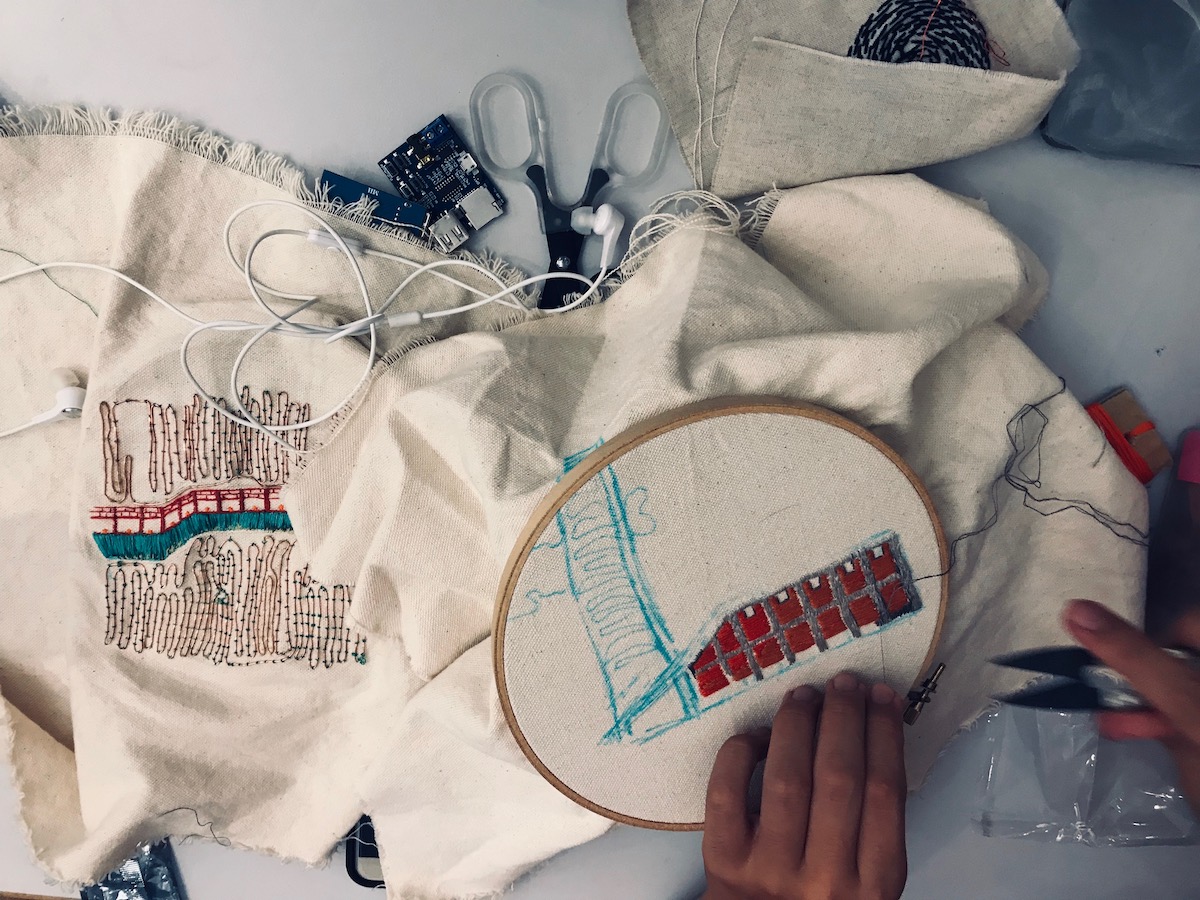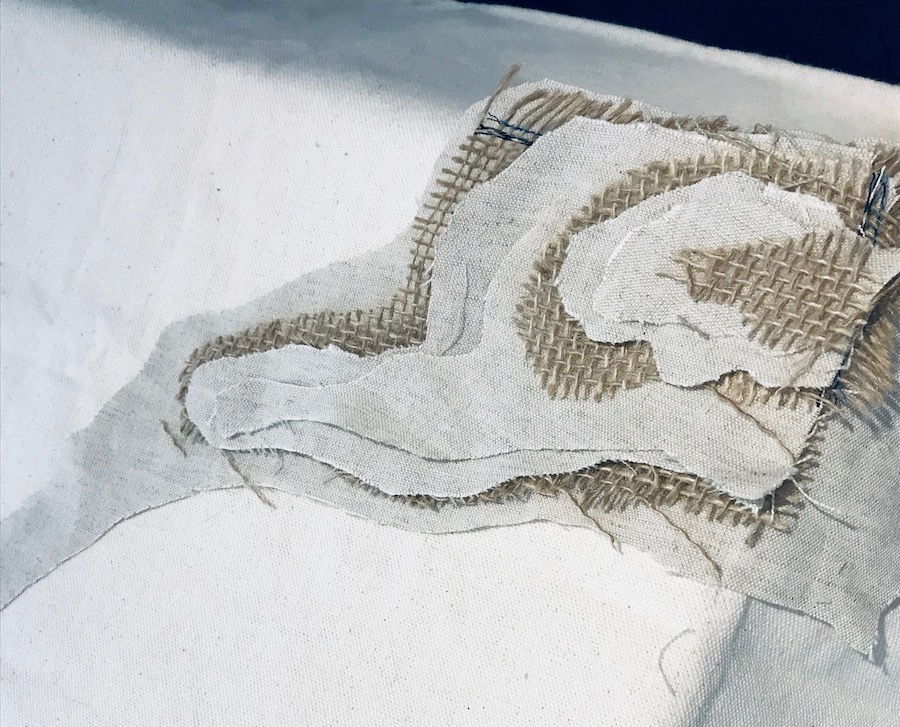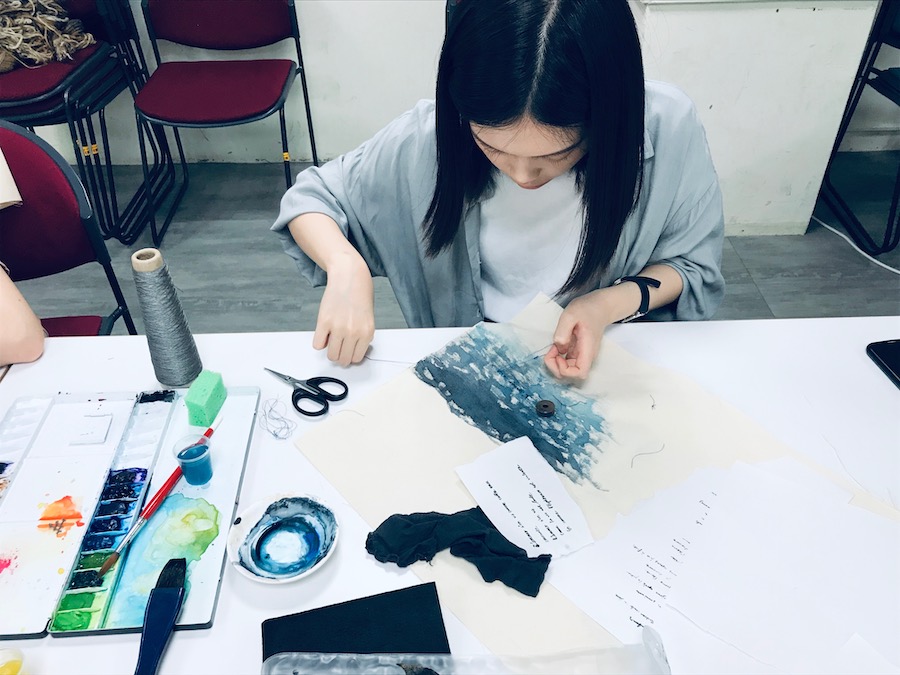// 林欣怡,〈一號廠房.補語〉,2019 // 第三種聲音 The Third Voice // 反身性聲語場景 The Reflexive Sound Scene
// 缺角字符.字義空缺.消音語意 // 氰版攝影、刺繡、導電線材、織物、電路板、放大器// Dia-City.Sound Embroideries
// 特別感謝:江秋梅、李博駿、龔台湘、汪少凡、陳靜如
//〈雙城.聲繡工作坊〉參與者:黃郁晴、侯祥鈺、陳玟瑄、張懿、謝賢德、劉科邦、陳曉涵、黃荷晴、呂紹文、尤柏勛、蔡欣岺
// 2019.06.06—07.09〈新竹生博物館六燃文件展〉 展出
// 〈雙城.聲繡〉結合「107 跨域創作實踐課程」與ICT「 聲繡工作坊」 2019.4.19—26
// 相關連結:〈考聲誌〉,2020、北赤土崎:一號廠房.空白之所,2018-2019

〈一號廠房.補語〉,氰版攝影、紗布、刺繡、導電線材、電路板、放大器、磁鐵,2019
[ 缺角補語 ]
被拆除的一角住所、被消音的一段話語、被遮蔽的一串回音
1949 北赤土崎 24.7984533 120.9983741 | 2015 一號廠房 24.798675 120.998318
以「雙城」作為實踐的方法—兩座城市、兩個年代,因為同樣的歷史事件(1949),將離散各地的我們因歷史事件而連結、織紋成交錯著異語言、異文化、異感知的關係網絡。「雙城」思考「來處—根」與「所在—路徑」的雙重歸屬,進一步將「六燃一號廠房」這個場所擴延成為溢出建築的關係連結。在方法上,「聲繡」作為構造空間場所的敘事旁白,透過聲音、話語以及身體對空間的感知,構成觸覺文本。聲繡以氰版攝影作為織物的基底影像,構造影像敘事圖層。圖樣內容為訪談對象的於媒體上被摘取出來的局部語句,在進行曬圖前先將文字拆解為「缺角補語」,曬圖完成後以紅線繡出「缺角補語」的再局部筆劃,使話語成為視覺上語意不清的「圖像」,觀者必須透過聲繡物件操作方能聽清受訪者的口述內容。〈補語〉指陳的不僅是以身體動作縫補佚失的事件片段與歷史場景、亦為一號廠房拆除事件回音的補述,而此回音因過多的現實角力被碎片化、雜訊化。
「聲繡」是包含了「聲音/具身/刺繡」(Sound, Embody, Embroidery)的身語,它並不以單一、線性的敘事角度進入場所描述,而是混融諸種不同的訪者、特定場點的歷史記憶和物件描述,作為嵌入式的敘事存檔系統,它將包括訪談時的傾聽、地方聲響的採集和擴延場所的交互詮釋。刺繡、織物不僅作為一種文化物質性的表徵,「縫補」的身體動作亦是一種多主體的交互理解與身體共感的過程,就物質性而言,也反應了家庭衣物織品破碎歷史的微型敘事。手工縫製讓每一個織物的局部細節,皆嵌入身體勞動的細密痕跡。更精確地說,是對時間、空間觸覺記憶檔案的再編碼、再生成。

As a space used to contain and juxtapose heterogeneous, connected structures, the Factory Building 1 in the area of Northern Chi Tu Qi created a social context of diasporic and unsettled dwellers for the Imperial Japanese Navy’s Sixth Fuel Factory, Hsinchu Branch. The embedded apartments as dwellings, on the one hand, conveyed the individuals’ identities, labor, and differences, and on the other hand served as a mapping of the demarcation, expansion, exchange, and reconfiguration of the dwellers’ bio-politics in this space. Based on this understanding and treating “Dia-City” as its practical method, the Factory Building 1 Project is intended to cogitate on the dual belongings of “origin—root” and “site—path.” In terms of methodology, the workshop of Sound Embroideries produces a haptic text with the narrative voice-over in this space, namely voice, speech, and physical sense of space. The “third voice” does not so much describe this space from a single, linear perspective as blends different interviewees as well as their memories of specific historical sites and depictions of objects into an embedded storage system of narratives, which includes the listening to the interviewees, the collection of local sounds, and the mutual interpretation of expanded places.
Textile embroidery is emblematic of cultural materiality, and the actions of sewing and mending imply a process of mutual understanding and synesthesia among multiple subjects. They also mirror the micro-narratives of the dwellers’ family history in their materiality. The approach of hand-making embeds partial details of each textile in the subtle traces of physical labor. On a more specific basis, it is nothing short of the recording and regeneration of the files of haptic memories of specific time and space. Based on their respective background contexts, the project participants will choose their preferred places for practice and recount the events unfolded therein. They will also discover related local sounds, thereby collectively excavating the writing of these spaces and creating corresponding soundscapes.
Embroidered Fabric Speaker
「聲繡」為 High-Low Tech Group :: MIT Media Lab 電子織物(e-textile)的應用創作。參與者將收集與場所有關的日常聲響,收於小型聲音播放模組電路板中,連結放大器,以導電線材織繡放音器圖樣於布料上,完成軟式、自控式的放音器。
These fabric speakers are made by running the 5-9V amplified sound signal through a very conductive coil in close proximity to a magnet. Unlike most speakers that have the wire coil wrapped cylindrically and placed around the magnet, here the coil is in the plane and directly adhered to the membrane that moves the air creating sound. ( High-Low Tech Group:: MIT Media Lab )
Inspired by Marcelo Coehlo’s paper speaker and Vincent Leclerc’s Accouphene textile speaker. Also see: etched fabric speaker, carved and engraved wood speakers, plated seashell speakers




